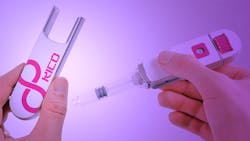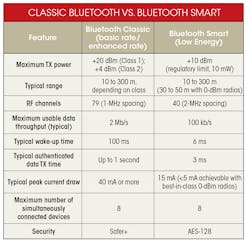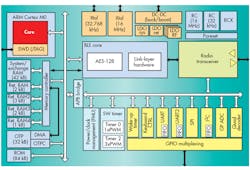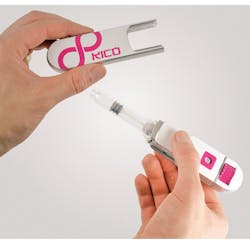Download this article in .PDF format
This file type includes high resolution graphics and schematics when applicable.
Bluetooth is already ubiquitous in smartphones, tablets, and notebook computers. All can be used to process and display data from a Bluetooth enable node, or transmit that data to other devices, and perhaps a cloud service, via Wi-Fi, cellular, or other link.
This has been possible for some time, but Bluetooth Smart makes the connection easier to implement in the IoT node. Reducing the power consumption reduces the load on the battery in the node and extends its life to months or even years. More exciting still is the opportunity to power small portable devices using energy-harvesting techniques, as the power budget for data links is driven down by further design innovation in Bluetooth Smart radios.
Like Classic Bluetooth, Bluetooth Smart operates in the 2.4-GHz ISM band, but consumes just 1/100th the average power in many applications. It achieves lower energy consumption primarily by keeping the radio switched off most of the time and by adopting smaller data packets. Using 2-MHz-wide channels, it offers a 1-Mb/s link rate and application throughput of just 100 kb/s.
In contrast, Bluetooth Classic using enhanced data rate (EDR) offers theoretical data rates up to 3 Mb/s, although the practical transfer rate is nearer to 2 Mb/s, making it better for data streaming at the expense of higher power consumption. However, low data rates, coupled with low duty cycles, are common requirements of many IoT monitoring and measuring applications.
Another significant difference between the standards is that Bluetooth Smart can set up authenticated connections in only 3 ms, much faster than the 100 ms of Classic Bluetooth. Quicker establishment of connections speeds responses to queries for data, and they consume less energy. Bluetooth Smart also addresses another increasingly important concern for many IoT applications: data security. Its encryption and authentication uses the U.S.-government developed 128-bit Advanced Encryption System (AES-128) (see the table).
Attractions of Energy Harvesting
For portable and wearable electronic devices, eliminating the battery not only reduces assembly effort during manufacturing, but also increases overall product reliability. It’s a positive step from an environmental perspective, too, since the disposal of spent batteries is a major concern.
Using a battery such as a lithium coin cell raises testability concerns as well, particularly in critical applications like medical devices. A power spike can render the cell useless, but the conditions to test for this over the entire lifecycle of a product are extremely difficult to implement. Furthermore, the self-discharge properties of batteries limit their lifetime in terms of shelf life and operating life.
However, the decision to move to energy harvesting places stringent demands on the control electronics. To be a convenient solution, the source of energy for harvesting has to come from normal product operation. The convenience of a battery-free design is lost if the user of a product has to go to great lengths to produce the energy needed to power it.
Impact on Medical Apps
The combination of ultra-low-power Bluetooth Smart and energy-harvesting technologies has promising applications in promoting health and fitness, and in medical monitoring. And when the electronics within the product is made as small and low power as possible, it simplifies the design of the energy-harvesting mechanism.
As a life-enhancing application example, diabetes sufferers need regular, precise injection of insulin to control the disease and minimize the risks of complications arising from it. After completing multiple designs of battery-based drug-delivery devices—ones that could detect dose delivery and forward the information to digital services—Cambridge Consultants realized that the same features could be implemented using Bluetooth and energy harvesting.
For instance, the energy required to power Cambridge Consultants' KiCoPen, a smart injection pen, is harnessed from the natural movement of the device when the user removes the cap for an injection and then replaces it. A magnetic weight moving close to a coil harnesses the energy from the motion. This movement induces a current in the coil that can be stored in the capacitor. Each oscillation of the magnetic actuator generates a consistent amount of energy. Even the number of reciprocating movements it makes on each action performed by the user can be tuned by adjusting the profile of a cam track.
The attraction of the device would be lost if the user had to shake or hold the pen for several seconds to get the product to work properly. This is particularly the case for those users who struggle to provide the motion necessary to recharge the system’s energy reservoir. For the KiCoPen, each cap removal or replacement action provides between 100 µJ and 200 µJ of energy that’s stored in the capacitor (Fig. 1).
A Cortex-M0 provides enough processing power for the application software. The software makes it possible to record each dose accurately and pushes readings into MRAM, waiting for activation of the Bluetooth Smart radio. Once its activities have been completed, the system enters a state where it can power down without any loss of important data. If the insulin-delivery data doesn’t transfer to the phone in one transaction, it’s stored in the pen, ready for the next attempt once the capacitor is recharged (Fig. 2).
Even if the pen runs out of power while the insulin is being injected, monitoring of delivery can still take place. The energy generated by lid replacement is often enough to measure the difference between the previous record and the current reservoir state, and therefore calculate the most recent dose.
Long-Term Prognosis
The combination of a novel energy-harvesting design and an ultra-low-power Bluetooth Smart SoC has resulted in a unique and effective concept for insulin delivery pens: It can capture the exact dose delivered and send the information to an associated smartphone app without requiring battery power. With the KiCoPen, diabetes sufferers can feel more confident they’re keeping up with their insulin regimen. The pen in combination with other electronic tools can lead to improved glycemic control, which in turn assists in reducing late-stage complications and helps patients lead longer and healthier lives.
Dialog Semiconductor’s SmartBond devices, such as the DA14580, give product designers a very small, low-power, and highly integrated way to quickly add reliable wireless communications to IoT devices that need to operate from harvested energy sources or require long-term operation from small batteries. The KiCoPen represents just one example of the effective deployment of such devices.
About the Author
Mark de Clercq
Product Marketing Group Manager
Mark joined Dialog Semiconductor in 2007 as Product Marketing Group Manager. Prior to this he was a design engineer at Phillips Electronics and held research and teaching posts at McGill University, where he took his Master’s degree in microelectronics. He has also studied strategic marketing at the Harvard Business School.
In his spare time, Mark enjoys getting out on his bike, self-tracking his progress using the latest app-enabled Bluetooth accessory.



